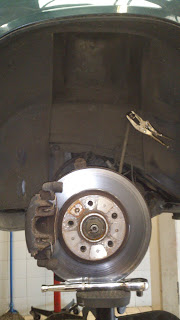Another quick, pictureless post to give a little update on the car. Not a lot has happened but if I don't write about it straight away, I'll only forget!
So, while shopping around for tyres yesterday, I found some Dunlops (in keeping with the BTCC theme) for £67 a corner. That's pretty good for a top brand, and it's the higher speed rating too. Here's a top tip for you - when buying tyres, also get a quote for slightly different sizes. The standard tyres on the Volvo 850 GLT are 195/60 R15 81 V (195mm wide, 60% profile, 15" radial, 81 load rating and V speed rating - 149mph) but I managed to save £10 per tyre by ordering 195/65 R15 81 V tyres. 5% on the profile will make basically no difference, so it's definitely worth trying next time your tyres start resembling Kojak!
Anyway, the place I got the tyres from (Stratford Tyres - if you're in South Warwickshire, they're worth a look) also does MOT testing, so I've bitten the bullet and booked the beast in for its test. Eek!
Things I know it will fail on:
- Tyres (hence ordering five of the buggers)
- Lights (there are a total of 3 bulbs out)
Things it'll probably fail on:
- Brakes (they're very corroded, but hopefully I can coax them back to life on the way to the test centre)
- Hand brake (it was always borderline before I laid it up)
- Emissions (the Lambda light is on, which suggests it's not running well - more on that later)
- Lights (I seem to remember the beam definition was a bit iffy last time it was tested)
And there are probably plenty of other things I don't know about!
So, to that Lambda light. Assuming this has come on due to old fuel, I took a trip to my local motorfactor this evening and purchased a shot of fuel system cleaner and a can of 10k Boost. I then stopped off on my way home to grab a gallon of Shell V-Power to try to up the octane in the tank a little bit.
I chucked the fuel system cleaner in the tank & washed it down with the new fuel. Then, following the instructions on the can, I administered the 10k Boost. This is basically a de-coking agent that works from inlet to exhaust. It is administered by spraying it directly into the plenum chamber (which involves removing a bit of ducting...) and revving the engine quite a bit.
The reason there are no pictures is because I was working in the dark. One benefit to this is that I actually witnessed my exhaust glowing cherry red under the car while I was working on it. Pretty cool.
After all that, the Lambda light is still on. At this point, I thought it would be a good idea to read off any fault codes & reset the ECU. This is a bit fiddly on a pre-OBD 850, but anyone can do it without special equipment.
To read the fault codes, simply locate the ECU interface (it sits behind the driver's side headlamp) and remove the cover. Insert the probe (ooh-er) into pin number 7 of the black (A) terminal and press the button once for about a second. The red LED will flash a sequence of 3 numbers at you. If it's 1-1-1, there are no codes to report. Anything else is a fault code and you should make a note of it. Press the button again for the next code and repeat until the first code is flashed out at you.
My car has 2 fault codes - 1-2-1 and 2-3-1. The latter relates to the fuel mixture, so I'm guessing that is the 'old fuel' problem. The former relates to the MAF (Mass Air Flow) sensor giving false readings, but this is most likely a result of the application of 10k Boost, as the MAF sensor is bypassed to do this.
I then had a go at resetting the codes. The procedure was from memory and didn't work. I've since googled it and will give you the correct procedure here.
Turn the ignition off, then back on to position 2. Insert the probe into terminal 7 and press the button 4 times. After a few seconds, the light comes on. Press the button once and wait for the light to come back on. Then press the button 5 times and wait for the light again. Once the light comes on, press the button once more and the ECU will be reset. Test by repeating the fault codes procedure - you should get 1-1-1.
I'll have another go at this before the MOT tomorrow to see if it clears the Lambda light.
That's all for now. Actually, that was a longer post than I thought, but never mind. I'll post again once I know the result of the MOT and let you know whether the reset procedure worked.
Once again, thanks for reading.


 Okay, wheel off, we can now get down to business. First, remove the nut from the bracket on the strut just above the brake disc. This is the end of the anti-roll bar.
Okay, wheel off, we can now get down to business. First, remove the nut from the bracket on the strut just above the brake disc. This is the end of the anti-roll bar.




















